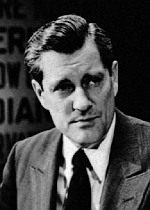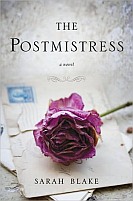HISTORICAL
FICTION
|
|

|
|

Edward R.
Murrow
|

Eric Sevareid :
CBS news journalist from 1939 to 1977. He was one of a group of elite
war correspondents—dubbed "Murrow's Boys"—because they were hired by
pioneering CBS newsman Edward R. Murrow
|

|
|
BOOK
ILLUMINATIONS
From Merrimon Book Reviews
|
|
The Postmistress
 by Sarah Blake
by Sarah Blake

Telling a story through edges: the voice of WWII and women's lives
In 1940, the lives of three women
could not be more different as war rages in Europe. Iris James,
postmistress of Franklin, Massachusetts, believes in order and
details. She takes great pride in her work. All
communications in the town come through her. The whole system
works because of the neat efficient system and the trust. She
keeps all the secrets of the residents, but one day, she breaks with
everything she has ever believed, slipping a letter into her
pocket. Emma Trask, wife of the town's doctor Will Fitch, listens
to all the
radio broadcasts from London with her husband. When a tragedy
provokes a change in her husband and a determination to go over to
Europe, Emma guards herself against the tides of war raging across a
distant ocean. In London, Frankie Bard, works with Edward R.
Murrow. Frankie listens to Murrow's story advice, yet her spirit
chafes against the all the strictures and protocol imposed on
her. Feisty, fearless and somewhat brash, she wants to get out
the truth and stir her listeners to action. In 1941, Frankie
rides the trains out of Germany, reporting on the war, listening to the
voices of the so-called refugees. As she sees the war unfolding
from a different perspective, her whole idea about the story itself
changes.
In THE POSTMISTRESS, Sarah
Blake looks at World War II through the eyes of three distinct women
all connected through means of private and public media. In many
ways, THE POSTMISTRESS itself
follows Frankie's conception of a news story as story and herein lies
the beauty of the novel. Sarah Blake's novel does not follow the
traditional concepts of a novel. THE POSTMISTRESS tells the story of
World War II through the edges, in the lives of the three women and the
events of their lives, often events that even seem unrelated to the
larger scene playing out in the world. Indeed, the
emotional impact of the story builds as Frankie stops trying to tell
the truth of the war and listens to the voices of those around
her. The "truth" of the war often emerges in the edges, in those
stories told and unspoken by the press and even the characters to some
extent. Although Sarah Blake draws on the history and historical
figures of the times, THE
POSTMISTRESS is not a historical novel filled with date and
details from the history books. The reader will not find all the
horrific details of the Holocaust or the London Blitz and yet, in
telling the story through the edges of war scene, THE POSTMISTRESS allows the
reader's imagination to enter the story. With the copious
amount of World War II history and fiction published, readers
undoubtedly are more than familiar with the main story of the War, and
yet, THE POSTMISTRESS brings
a freshness to the story. For this reader, THE POSTMISTRESS, is one of the
first to tell the story of the trains from a viewpoint that truly
engages imagination and emotion in both the details of individuals,
sometimes even the characters for whom only a name and place is known,
who might have experienced the events. Like Frankie's approach to
the story, less is sometimes more. Equally, the conflicts and
struggles of Emma Fitch and Iris James bring a whole other emotional
dimension and texture to the story.
THE POSTMISTRESS
is a wonderful blend of popular women's fiction and literary
fiction. The novel gains more emotional power and intellectual
interest as it progresses. The first part reads more like light
women's fiction as the author introduces the three women whose lives
will touch one another's. Frankie's development, however, guides
the heart of the story, developing the lens through which the richness
of the other characters emerges. The beginning of the story
actually gains more relevance and emotional depth in hindsight, as
Frankie's less traditional concept of a news story begins to cast the
novel itself within a different framework. THE POSTMISTRESS is a story of
women's lives, of life, death and love during WWII, and by end, a story
about the art of storytelling itself.
Publisher: Amy Einhorn Books/Putnam
(February
9, 2010)
Author
website
Author
blog
Reviewed by Merrimon,
Merrimon Book Reviews
Review
Courtesy of Amazon
Vine

|
|
|